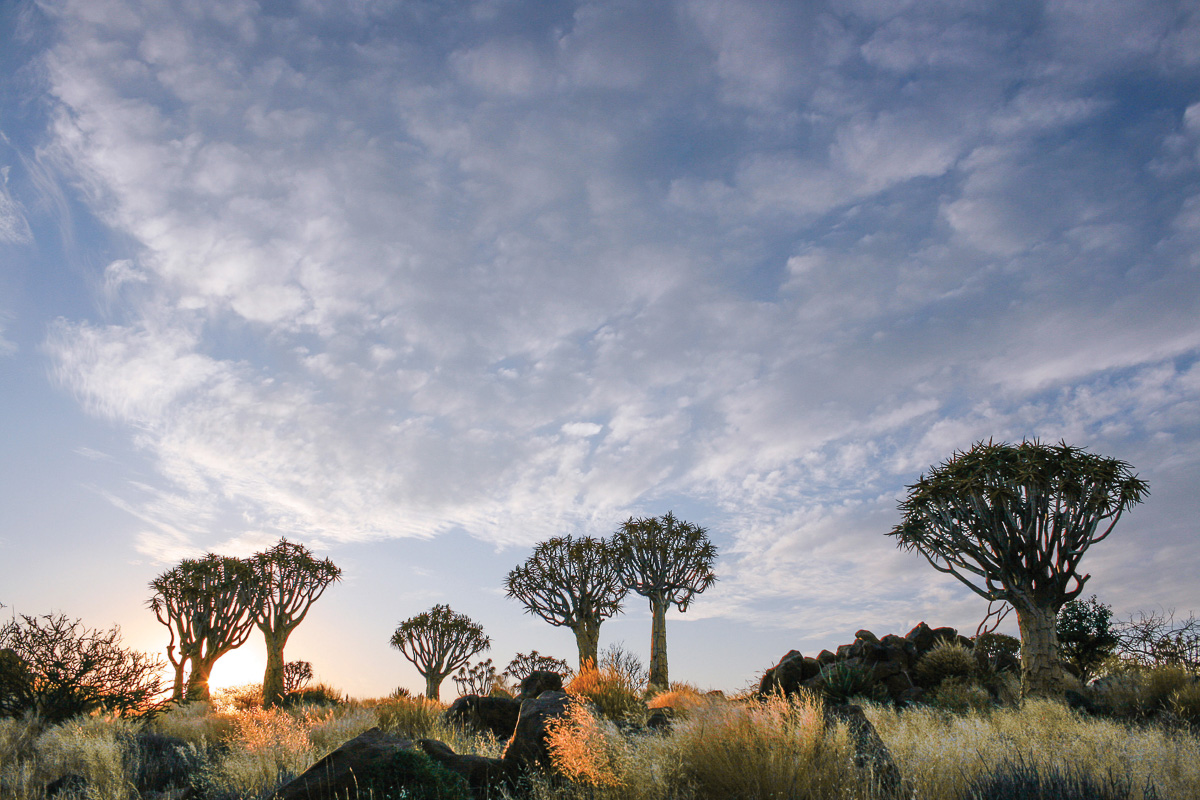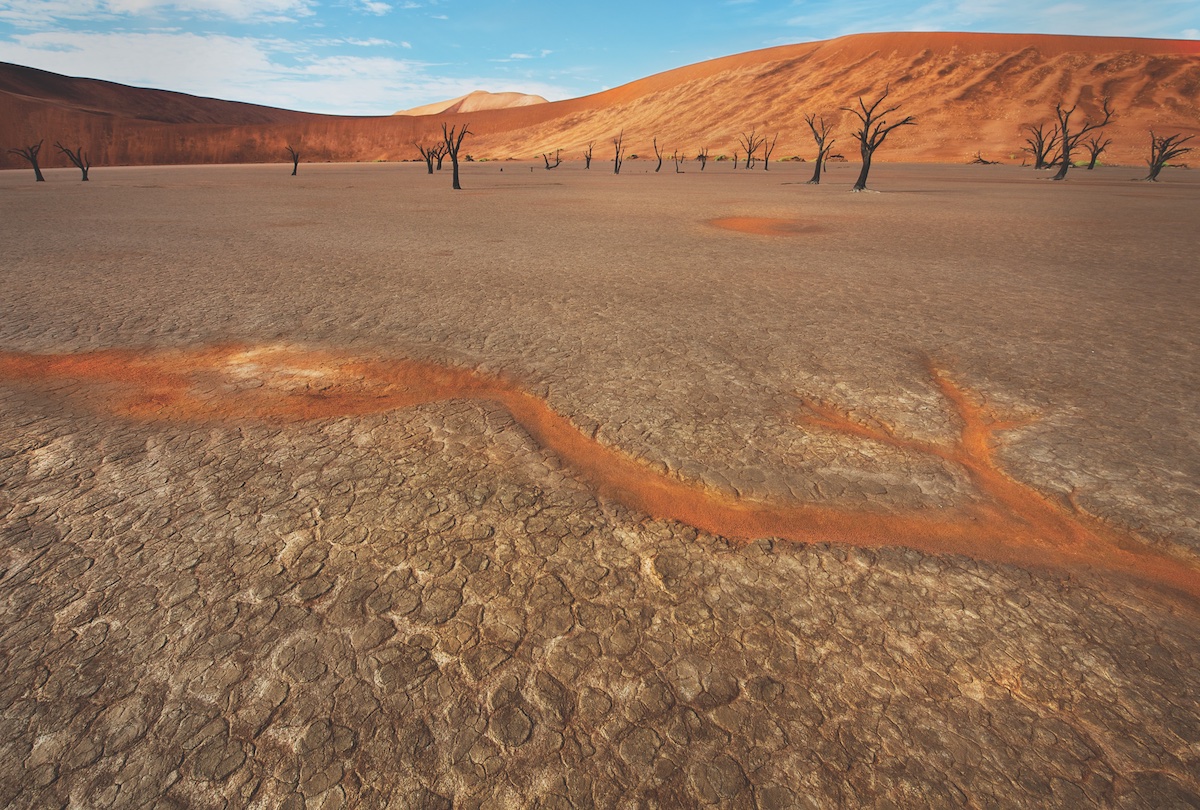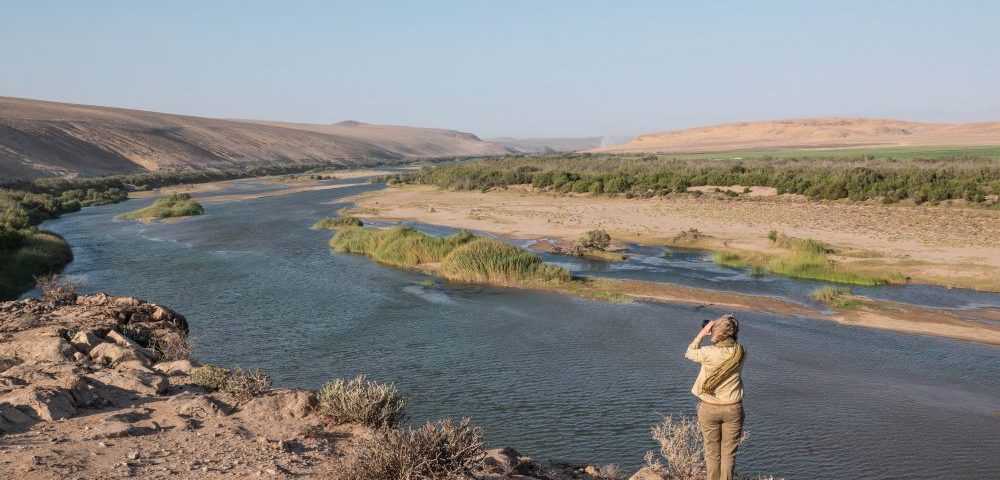
The quiver tree forrest: A spine quivering sunrise
December 11, 2019
Explore Sossusvlei and the Namib-Naukluft
December 13, 2019While gemsbok all over the country are known to be elusive animals, those in the south-westernmost corner of the Tsau //Khaeb National Park are of a different breed. Hard to believe they stem from the same legendary beast, these gemsbok have made the cosy town of Oranjemund their home. Here they wander lazily through the streets, doze under shady trees, and munch on fresh, green lawn when hunger hits. Although placed in the midst of a wild and ancient desert, these animals have become so comfortable with their luxury environment that the human residents had no choice but to accept their company. The gemsbok has since become the official representative of the town and features proudly on its coat of arms.
Text Marita van Rooyen
To appreciate the gemsbok in Oranjemund it’s necessary to understand the history of the town. Without the presence of humans, there would be no lawn for the gemsbok to nibble on, but without diamonds, there would be nothing at all.
Established in 1936 as a mining town – to cater for the growing number of workers exploiting mineral deposits in the desert of south-western Africa – Oranjemund is strategically located on the northern bank of the Orange River, an area that has been known for many years as one of the richest diamond fields in the world.
For decades the town flourished as a self-sustaining hub in the desert, created and provided for by the mine, in its various representations over the years. Inhabitants lived in a sheltered bubble, restricted to employees of the mine and their relatives, impenetrable by the outside world. Everyone was granted housing and basic services free of charge, and the town had its own cattle farm and vegetable gardens to supply all sorts of fresh produce to its residents. Social life was seen as key to the mental state of the inhabitants, and sports and cultural clubs were the order of the day. So was religion, with at least six churches in town representing various denominations. Life in the sheltered diamond town of Oranjemund continued undisturbed for more than 80 years.
A TOWN IN TRANSFORMATION
Oranjemund opened its doors to the public in October 2017. Six years earlier it was proclaimed as a town and had begun the process of decoupling the town and mine. A transformation journey driven by Oranjemund (OMD) 2030 – a collaboration between the mine, the public sector and local citizens – it aims to create a sustainable environment for the town to thrive beyond mining.
The OMD 2030 community organisation has since introduced a variety of initiatives centred on the five project areas of tourism, communication, community engagement, training and education. Night markets, cultural evenings, movie nights and bird counts have become regular events, while recycling centres have taken off and waterwise gardens were established. Newsletters and other communication channels have been set up, while learner exchange programmes and various partner projects are being initiated simultaneously.
The latest partners to join the transformation are two Namibian start-ups, Dololo and SunCycles. Dololo is an entrepreneurship development agency which connects organisations and leaders through innovation sessions, impact workshops, coaching and team building. The agency is compiling a database on entrepreneurial activities in Oranjemund and plans to launch a support programme for small businesses, to provide training opportunities for the community.
Specialised in e-mobility, SunCycles has been instrumental in assisting OMD in creating eco-friendly sightseeing activities in the surroundings for both visitors and locals. As a social enterprise the team supplied locally designed and assembled e-bikes to OMD 2030, and also provided training to local entrepreneurs to operate, maintain and service the bikes, thus generating additional business opportunities.
More options to secure the sustainability of the town are being explored, and as the town’s first elected Mayor, Henry Coetzee, puts it: “…experience the spirit of Oranjemund, make a positive contribution towards the country’s economy and help create a first-in-kind sustainable model town in Namibia”.
Experience Oranjemund in the midst of its transformation – and say hi to the gemsbok! TNN
ORANJEMUND’S MOST FAMOUS INHABITANT
It is said that in ancient Egyptian culture the oryx was a symbol of Seth, the god of chaos and the untamed desert. For many generations this magnificent creature enjoyed a reputation as a mysterious desert-adapted mammal. Boasting a mean set of horns, purposefully applied during self-defence, and a powerful body that can run up to 60 km/h, the oryx is capable of surviving without food and even without water for days. Four different species are found in arid regions across Africa, and the largest of them calls Namibia’s harsh deserts its home: Oryx gazella, or simply, the gemsbok.
HOW TO GET THERE
The long straight road down south is already a journey in itself, but they say when you hit the newly tarred stretch between Rosh Pinah and Oranjemund, you’re on the road to heaven – it’s that beautiful. From Windhoek, the distance is 976 km when you take the main highway south, or 826 km on the slow and winding way. If time is of the essence, get onto a FlyWestair flight from Windhoek to Oranjemund, which takes just over an hour and is available three times a week.
For more information about Oranjemund, activities, accommodation and eateries see www.omd2030.com. For more on Dololo and SunCycles’ involvement in the transformation, visit www.dololo.io and www.ebikes4africa.org.
WHAT TO DO IN ORANJEMUND
OMD 2030 has its Hub in Seventh Road, across from Spar – which you can’t miss because it is the only grocery store in town. The Hub is where locals and visitors can get information on activities and tours, make use of WiFi and printing services, buy locally-made souvenirs in the gift shop, or rent the venue for conferences and events. The Hub also rents out e-bikes, providing an ideal opportunity to pack some snacks and explore the town and surroundings at your own pace.
Next door the Jasper House Heritage Centre – the oldest building in the town and residence of the first mine manager – is now a museum where artefacts and records of the Sperrgebiet and early exploration years are displayed. The Heritage Centre houses a coffee shop in its garden, along with old digging machinery used during the early mining years.
While a walk (or e-biking) through town is already an activity in its own, public facilities are available in the form of a well-maintained swimming pool, library and various private clubs where visitors are always welcome, plus activities like horse riding and badminton.
The Sands “Hotel” Complex is a must on any first-timer’s list: With more than 157 bars (10 of which are currently closed), all tightly packed into a maze of alleyways, it was established in the 1970s as an entertainment area for the mineworkers, and today still very much serves as the preferred spot to socialise after a hard day’s work.
If you’d rather relax playing golf than having a beer, the Oranjemund Golf Club is renowned for being one of the toughest in the country, with golfers frequently being tested by unforgiving winds and punishing roughs. This is desert golfing at its best.
A bit further westwards, along one of only two public access roads (the other one is the M118 to Rosh Pinah in the northeast), the lush Orange River delta spreads out to the ocean. A Ramsar Site, it is home to more than 4 000 birds of 40 different species that nest along its shores. Picnic and lookout spots, dotted along the river, invite you for a break to reflect on the incredible fauna and flora that inhabit these desert-adapted ecosystems. Met by the ocean with stubborn persistence, the Orange River Mouth changes in appearance from day to day, as sandbanks push and shift the flow of water. Along the beach – of which only about one kilometre is accessible to the public – a number of vibrantly painted braai areas, sheltered against the elements, provide space for lunch.
Known as the link between the Richtersveld in South Africa and the Namib Desert flora, the flat top of Swartkops Hill is a Nature Reserve. Often visited by brown hyena and black-backed jackal, it is a biodiversity hotspot with succulents found nowhere else on earth. Swartkops is located within easy reach of the town and a great location for enjoying the sunset with 360-degree panoramic views, 70 metres above the river and surrounding desert.
When you have a day, or rather a night to spare, Hohenfels is worth a visit (it’s open for campers). Rumour has it that the ruins of an old imperial German police and customs station now houses the ghost of the Nama mistress who died in distress, murdered by her German lover’s jealous daughter. While Hohenfels is a bit further out of town (roughly 20 km), it does offer spectacular vistas from high up on the “high rock” after which it was named, above the riverbank.


